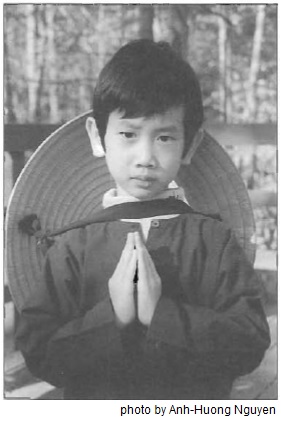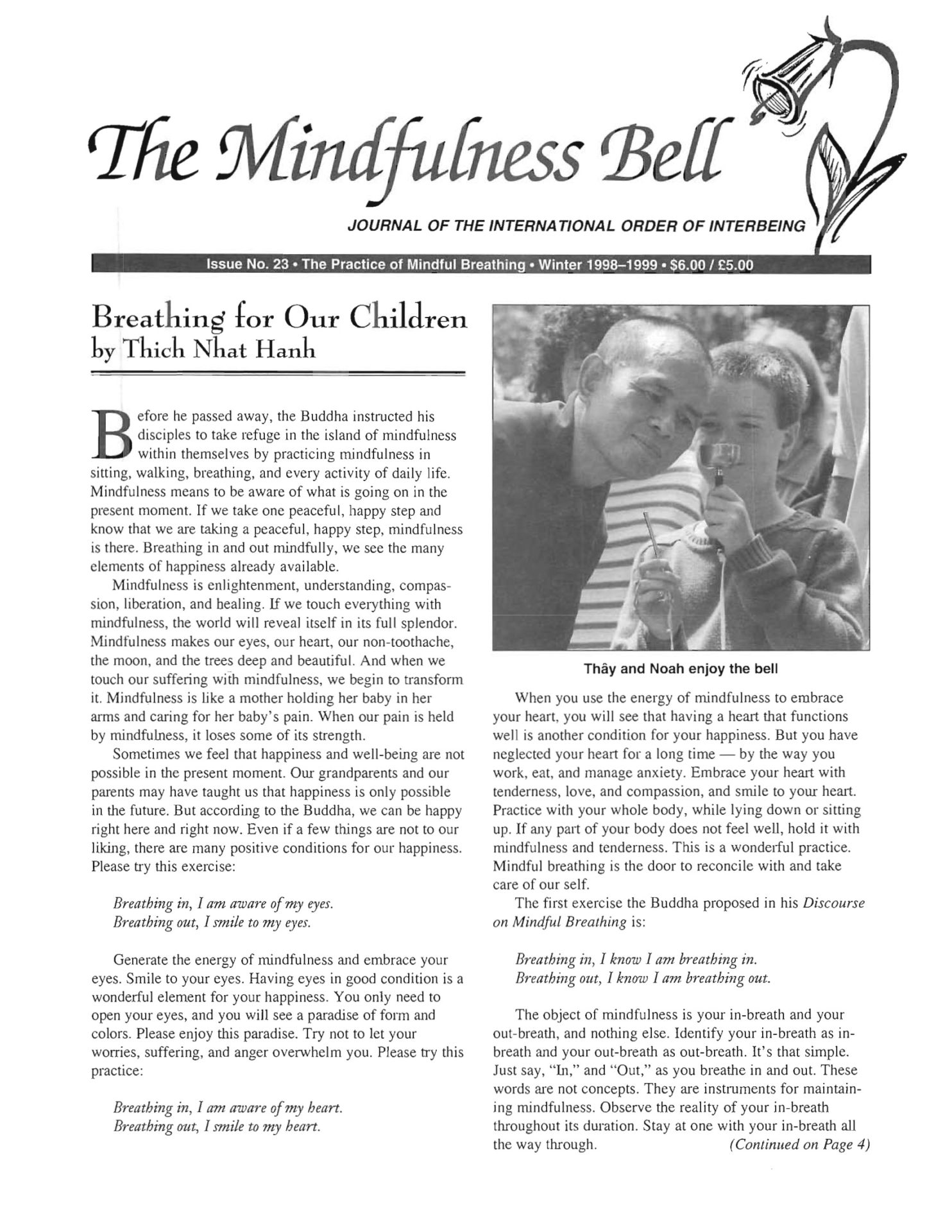By Nguyen Anh-Huong in December 1998
Breathing in, I know I am breathing in. Breathing out, I know I am breathing out.
When I invest all of my being into my breath, this exercise becomes a mantra. I entrust myself completely to my breathing, and I know I am safe. Mindful breathing is my anchor.
Many young people suffer because they don’t know what to do in times of strong emotion.
By Nguyen Anh-Huong in December 1998
Breathing in, I know I am breathing in. Breathing out, I know I am breathing out.
When I invest all of my being into my breath, this exercise becomes a mantra. I entrust myself completely to my breathing, and I know I am safe. Mindful breathing is my anchor.
Many young people suffer because they don't know what to do in times of strong emotion. They need the anchor of their breath. A few weeks ago, I shared the technique of belly-breathing with a group of fifth-grade students. I told them to use it in times of strong emotions. They listened attentively and practiced very well. These young people need our help to enter the heart of the Buddha and learn to take refuge in their safe island of self. My family escaped from
Vietnam in a very small boat. None of us could swim. Before we left, my father tied eight floats on both sides of the boat. On the open sea, our boat was caught in a terrible storm. The boat engine stopped. I peeped out of the boat. The waves were so high, all I could see was water- no sky, no horizon, just water everywhere. If my father had not tied floats on the boat, we would all have been in the bellies of the fish. Mindful breathing is like the floats on our small boat. By holding onto our breathing, we are able to go safely through the storms of life.

Allowing our body to relax is the key to enjoying our breathing. The breath is part of the body. When the body is at ease, breathing becomes natural and relaxed. Since conscious breathing is a bridge connecting body and mind, the breath is also part of the mind. When the breath is calm, it calms the mind. I like to see my breathing as a pillow on which I rest: "Breathing in, I am resting on the pillow of my in-breath. Breathing out, I am resting on the pillow of my out-breath."
The practice of mindful breathing is the practice of stopping. Someone asked when to stop. The answer is "now." There is such a lot of confusion, misunderstanding, and suffering in each of us and in the world today it is important for us to learn and practice the skill of stopping. When we discover that we are running into an accident, our only wish is to be able to stop. And we can achieve stopping by holding onto our anchor of conscious breathing. Stopping helps us realize the absence of accident-the presence of safety and happiness. A half-smile is the fruit of that realization. Forgetfulness is the kind of energy that makes us run away from the present moment, and is the cause of many of our accidents. Missing our steps as we walk on earth is an accident. Missing the looks and the smiles of our beloved ones at the dinner table is another accident. The moment we come back to our breath, forgetfulness is being transformed into remembrance, mindfulness, happiness, and compassion.
The practice of conscious breathing is indeed the beginning of and the basis of the practice of love. The practice of a half-smile always goes with the practice of mindful breathing. A smile is both a means and an end. We smile to acknowledge and nurture the joy that is present, so that our joy may continue to grow. When happiness pervades our whole being, a half-smile blooms on our lips, in our eyes, and beneath our steps-without any effort. Several people have asked: "How can I smile when there is no joy in my heart?" The feeling of joy may not be present, but the seed of joy is there. It only needs to be touched and watered.
Mindful breathing helps us water the seeds of joy by connecting with the elements of joy within and around us: "Breathing in, I feel the blood flowing in my body. Breathing out, I am in touch with the sound of water trickling in the creek." Friends in the practice can help us touch our seed of joy. Our smile can also help us touch our seed of joy. We do not have to feel joy to smile. We smile to wake up the seed of joy sleeping in the soil of our mind. It may not seem too difficult to smile to others, yet it can feel strange to smile to ourselves. More than anyone, we deserve our smile. If we cannot smile to ourselves, something is in the way, preventing us from accepting and loving our self.
Suppose one winter day, we come home and the house is cold. We light the fireplace. After a while, the room becomes warm and comfortable. Our energy of mindfulness embraces our pain in the same way. The act of making a fire is born from an insight that the room is cold and the desire to warm the room. When we realize that we are suffocating in our pain, deep in our heart is born the desire to relieve our suffering. Our half-smile is the manifestation of that awakening and desire. Our half-smile is a breath of fresh air which brings immediate relief to our pain. It proves that we have compassion towards ourselves. Before the match is struck, the fire logs cannot produce wann air. Similarly, we must touch the seed of self-compassion for mindful breathing to produce the energy needed for transformation. Mindful breathing is the practice of compassion: "Breathing in, I smile to my in-breath. Breathing out, I smile to my whole body."
Holding onto our breathing is an art. It requires self-training and practice. By nurturing ourselves with the ease and joy of conscious breathing while strong emotions are not there, we will remember to return to our breath the moment strong emotions start to arise. If our instability is so great that we cannot hold onto and experience a sense of safety in our breath, one of the following methods can be used.
First, we can revive trust in ourselves and in the practice by recalling any feeling of peace and stability that was produced by our conscious breathing in the past. This can be done most easily when we are in an environment conducive to the practice, such as in a park or beside a river. The energy of trust helps us reconnect and entrust ourselves to our breath again. Second, we can ask for support from our Sangha brothers and sisters who are quite solid and loving. Their presence and their words bring us relief and enable us to taste the safety of our breath again. Third, we can allow ourselves to be embraced by a loving, supportive community that has the practice of peace, joy, stability, and compassion as its foundation. Breath is life. If we cannot experience the safety of conscious breathing and the joy of being alive, we are like wilted flowers. A practice community is good soil where each practitioner is trained to be a skillful gardener. Good soil and well-trained gardeners together can transform wilted flowers into fresh flowers. Taking refuge in the Sangha is to entrust ourselves completely to the practice and wisdom of the Sangha. The Sangha is the anchor. If the Sangha is a true Sangha, we will be able to experience the joy of conscious breathing in order to be healed and transformed.
In one retreat, a woman expressed feeling numb toward her breath. Belly-breathing did not work for her. It is true that when our mind and body become very tense, we may not be able to feel our breathing. I asked her to lie down and allow herself to be held tenderly in the arms of the Mother Earth as several imagery exercises were offered to help her relax. After 20 minutes, she began to feel her in-breath and her out-breath. Later in the retreat, as tears came to her eyes, she shared with friends her feeling of peacefulness with the practice of belly-breathing. This miracle could not have happened without a loving, supportive Sangha. It is autumn in Virginia. Each day, I receive many beautiful leaves from our five-year-old son, Bao-Tich.
Whenever he steps through the door, his face is as radiant as the leaf in his hands. Looking at Bao-Tich, I realize how happy he was to encounter the leaf, pick it up, bring it home, and offer it to me. For him, each autumn leaf is a true wonder. He encounters each leaf as if it is everything. He looks so happy and satisfied! Everyone was once a child like Bao-Tich. We were happy and satisfied with "little things" such as the leaves, the pebbles, the twigs, the acorns. We looked up at the sky and talked to the birds. Our smile shows our desire to revive that capacity. A smile is the rain and the sunshine. It has the power of liberating us from holding enmity toward ourselves and others. A smile can transform dry earth into fertile soil. Our smile seals us to the present moment.
A mindfulness practitioner is a love weaver. When we practice mindful breathing-whether sitting, standing, walking, or lying down--each breath is a thread woven into a cradle of love. Thanks to this cradle, we have a place to hold and nurture our joy, to hold and lullaby our pain. Transformations take place in this very cradle.
Dharma teacher Anh-Huong, Chan Y, facilitates the Mindfulness Practice Center in Fairfax, Virginia. She is the founder of The Committee for the Relief of Poor Children in Vietnam, which helps poverty-stricken children and orphans in Vietnam.

